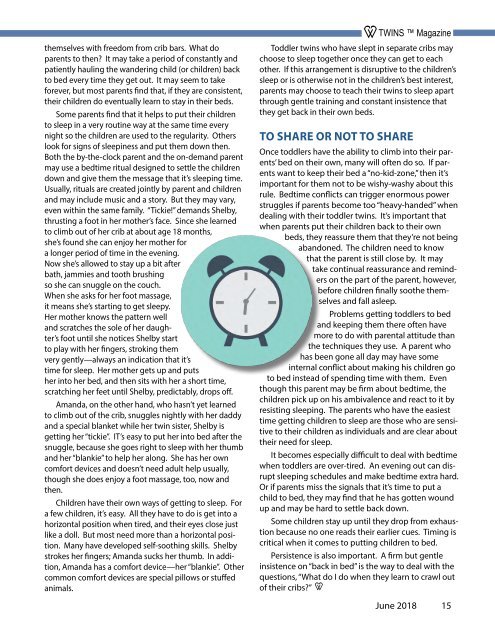2018_JUNE_FINAL
You also want an ePaper? Increase the reach of your titles
YUMPU automatically turns print PDFs into web optimized ePapers that Google loves.
themselves with freedom from crib bars. What do<br />
parents to then? It may take a period of constantly and<br />
patiently hauling the wandering child (or children) back<br />
to bed every time they get out. It may seem to take<br />
forever, but most parents find that, if they are consistent,<br />
their children do eventually learn to stay in their beds.<br />
Some parents find that it helps to put their children<br />
to sleep in a very routine way at the same time every<br />
night so the children are used to the regularity. Others<br />
look for signs of sleepiness and put them down then.<br />
Both the by-the-clock parent and the on-demand parent<br />
may use a bedtime ritual designed to settle the children<br />
down and give them the message that it’s sleeping time.<br />
Usually, rituals are created jointly by parent and children<br />
and may include music and a story. But they may vary,<br />
even within the same family. “Tickie!” demands Shelby,<br />
thrusting a foot in her mother’s face. Since she learned<br />
to climb out of her crib at about age 18 months,<br />
she’s found she can enjoy her mother for<br />
a longer period of time in the evening.<br />
Now she’s allowed to stay up a bit after<br />
bath, jammies and tooth brushing<br />
so she can snuggle on the couch.<br />
When she asks for her foot massage,<br />
it means she’s starting to get sleepy.<br />
Her mother knows the pattern well<br />
and scratches the sole of her daughter’s<br />
foot until she notices Shelby start<br />
to play with her fingers, stroking them<br />
very gently—always an indication that it’s<br />
time for sleep. Her mother gets up and puts<br />
her into her bed, and then sits with her a short time,<br />
scratching her feet until Shelby, predictably, drops off.<br />
Amanda, on the other hand, who hasn’t yet learned<br />
to climb out of the crib, snuggles nightly with her daddy<br />
and a special blanket while her twin sister, Shelby is<br />
getting her “tickie”. IT’s easy to put her into bed after the<br />
snuggle, because she goes right to sleep with her thumb<br />
and her “blankie” to help her along. She has her own<br />
comfort devices and doesn’t need adult help usually,<br />
though she does enjoy a foot massage, too, now and<br />
then.<br />
Children have their own ways of getting to sleep. For<br />
a few children, it’s easy. All they have to do is get into a<br />
horizontal position when tired, and their eyes close just<br />
like a doll. But most need more than a horizontal position.<br />
Many have developed self-soothing skills. Shelby<br />
strokes her fingers; Amanda sucks her thumb. In addition,<br />
Amanda has a comfort device—her “blankie”. Other<br />
common comfort devices are special pillows or stuffed<br />
animals.<br />
A TWINS Magazine<br />
Toddler twins who have slept in separate cribs may<br />
choose to sleep together once they can get to each<br />
other. If this arrangement is disruptive to the children’s<br />
sleep or is otherwise not in the children’s best interest,<br />
parents may choose to teach their twins to sleep apart<br />
through gentle training and constant insistence that<br />
they get back in their own beds.<br />
To Share or Not to Share<br />
Once toddlers have the ability to climb into their parents’<br />
bed on their own, many will often do so. If parents<br />
want to keep their bed a “no-kid-zone,” then it’s<br />
important for them not to be wishy-washy about this<br />
rule. Bedtime conflicts can trigger enormous power<br />
struggles if parents become too “heavy-handed” when<br />
dealing with their toddler twins. It’s important that<br />
when parents put their children back to their own<br />
beds, they reassure them that they’re not being<br />
abandoned. The children need to know<br />
that the parent is still close by. It may<br />
take continual reassurance and reminders<br />
on the part of the parent, however,<br />
before children finally soothe themselves<br />
and fall asleep.<br />
Problems getting toddlers to bed<br />
and keeping them there often have<br />
more to do with parental attitude than<br />
the techniques they use. A parent who<br />
has been gone all day may have some<br />
internal conflict about making his children go<br />
to bed instead of spending time with them. Even<br />
though this parent may be firm about bedtime, the<br />
children pick up on his ambivalence and react to it by<br />
resisting sleeping. The parents who have the easiest<br />
time getting children to sleep are those who are sensitive<br />
to their children as individuals and are clear about<br />
their need for sleep.<br />
It becomes especially difficult to deal with bedtime<br />
when toddlers are over-tired. An evening out can disrupt<br />
sleeping schedules and make bedtime extra hard.<br />
Or if parents miss the signals that it’s time to put a<br />
child to bed, they may find that he has gotten wound<br />
up and may be hard to settle back down.<br />
Some children stay up until they drop from exhaustion<br />
because no one reads their earlier cues. Timing is<br />
critical when it comes to putting children to bed.<br />
Persistence is also important. A firm but gentle<br />
insistence on “back in bed” is the way to deal with the<br />
questions, “What do I do when they learn to crawl out<br />
of their cribs?” A<br />
June <strong>2018</strong> 15

















